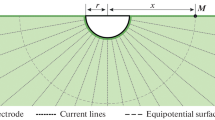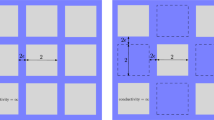Abstract
We consider the Casimir energy for a system of conducting parallel planes with constant surface conductance and obtain a general expression for the Casimir energy of the systems of two, three, and four planes. For equal separations between the planes, the energy is inversely proportional to the cubed distance between the planes and for low conductance is independent of the Planck constant and the speed of light. For a system of ideally conducting planes, the Casimir energy is the sum of the Casimir energies of pairs of adjacent planes.
Similar content being viewed by others
References
H. B. G. Casimir, Proc. K. Ned. Akad. Wetensc., 51, 793–795 (1948).
M. Bordag, U. Mohideen, and V. M. Mostepanenko, Phys. Rep., 353, 1–205 (2001); arXiv:quant-ph/0106045v1 (2001).
K. A. Milton, J. Phys. A: Math. Gen., 37, R209-R277 (2004).
S. Y. Buhmann and D.-G. Welsch, Prog. Quantum Electron., 31, 51–130 (2007).
G. L. Klimchitskaya, U. Mohideen, and V. M. Mostepanenko, Rev. Modern Phys., 81, 1827–1885 (2009).
K. A. Milton, Casimir Effect: Physical Manifestation of Zero-Point Energy, World Scientific, Singapore (2001).
M. Bordag, G. Klimchitskaya, U. Mohideen, and V. Mostepanenko, Advances in the Casimir Effect (Intl. Ser. Monogr. Phys., Vol. 145), Oxford Univ. Press, Oxford (2009).
E. M. Lifshitz, Sov. Phys. JETP, 2, 73–83 (1956).
I. E. Dzyaloshinskii, E. M. Lifshitz, and L. P. Pitaevskii, Sov. Phys. Usp., 4, 153–176 (1961).
Yu. S. Barash and V. L. Ginzburg, Sov. Phys. Usp., 18, 305–322 (1975).
J. S. Dowker and R. Critchley, Phys. Rev. D, 13, 3224–3232 (1976).
S. W. Hawking, Commun. Math. Phys., 55, 133–148 (1977).
S. K. Blau, M. Visser, and A. Wipf, Nucl. Phys. B, 310, 163–180 (1988).
E. Elizalde, S. D. Odintsov, A. Romeo, A. A. Bytsenko, and S. Zerbini, Zeta Regularization Techniques with Applications, World Scientific, Singapore (1994).
M. Bordag, E. Elizalde, K. Kirsten, and S. Leseduarte, Phys. Rev. D, 56, 4896–4904 (1997); arXiv:hep-th/9608071v1 (1996).
Yu. S. Barash and V. L. Ginzburg, Sov. Phys. Usp., 27, 467–491 (1984).
V. V. Nesterenko and I. G. Pirozhenko, Phys. Rev. A, 86, 052503 (2012).
N. R. Khusnutdinov and A. R. Khabibullin, Theor. Math. Phys., 166, 66–80 (2011).
M. Bordag and N. R. Khusnutdinov, Phys. Rev. D, 77, 085026 (2008); arXiv:0801.2062v1 [hep-th] (2008).
K. S. Novoselov, A. K. Geim, S. V. Morozov, D. Jiang, Y. Zhang, S. V. Dubonos, I. V. Grigorieva, and A. A. Firsov, Science, 306, 666–669 (2004); arXiv:cond-mat/0410550v1 (2004).
L. A. Falkovsky and A. A. Varlamov, Eur. Phys J. B, 56, 281–284 (2007).
A. B. Kuzmenko, E. van Heumen, F. Carbone, and D. van der Marel, Phys. Rev. Lett., 100, 117401 (2008).
R. R. Nair, P. Blake, A. N. Grigorenko, K. S. Novoselov, T. J. Booth, T. Stauber, N. M. R. Peres, and A.K. Geim, Science, 320, 1308–1308 (2008).
I. V. Fialkovsky, V. N. Marachevsky, and D. V. Vassilevich, Phys. Rev. B, 84, 035446 (2011); arXiv:1102.1757v2 [hep-th] (2011).
V. N. Marachevsky, J. Phys. A: Math. Theor., 45, 374021 (2012).
V. N. Marachevsky, Internat. J. Mod. Phys., 14, 435–444 (2012); arXiv:1111.3612v1 [hep-th] (2011).
D. Drosdoff and L. M. Woods, Phys. Rev. B, 82, 155459 (2010).
N. Khusnutdinov, D. Drosdoff, and L. M. Woods, Phys. Rev. D, 89, 085033 (2014); arXiv:1404.2532v1 [quantph] (2014).
Author information
Authors and Affiliations
Corresponding author
Additional information
__________
Translated from Teoreticheskaya i Matematicheskaya Fizika, Vol. 183, No. 1, pp. 51–61, April, 2015.
Rights and permissions
About this article
Cite this article
Khusnutdinov, N.R., Kashapov, R.N. Casimir effect for a collection of parallel conducting surfaces. Theor Math Phys 183, 491–500 (2015). https://doi.org/10.1007/s11232-015-0276-0
Received:
Published:
Issue Date:
DOI: https://doi.org/10.1007/s11232-015-0276-0




